From the model’s clothing to the background setting, learn how David Tanner uses various elements to create an engaging narrative painting featuring athletes, dancers, and more.
By David Tanner
davidtannerfineart.com
I’m often asked about the evolution of my narrative figure paintings. In some instances, I have a concept in advance, so I choose a model whose expressive capabilities help put the story across. Other times, the process begins with the model inspiring the story.
Either way, before the actual painting is begun, I enter a period of experimentation through sketches and photography to guide me through compositional possibilities. In this article, I’ll refer to multiple paintings in order to explain various parts of the process.
The exploration of a narrative painting begins with an an alla prima (single-session) oil study of the model’s head and shoulders. This allows me to become acquainted with the planes of the face and coloring. One of the great things about working with a model from life (in person, as opposed to working from photographs) is the opportunity to have conversations and learn about the person’s life and interests. This comfort level, for both the model and me, can inspire many paintings of the same model . . . some may be formal, planned compositions, while others are simply loose sketches to explore a particular lighting, pose, or mood.
There are characteristics that are unique, and evident only after spending time with a person. A camera often misses minute changes in expression that are so indicative of a person’s “look.” Studying the face for a two- to three-hour painting session, I notice slight changes that can lead to capturing those unique characteristics.
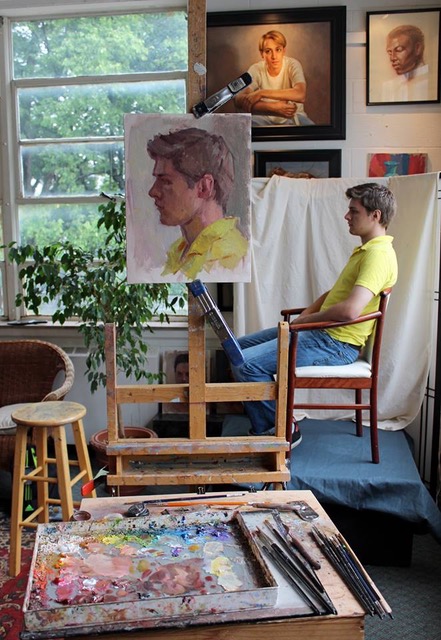
All that said, I’m in no way committed to painting an exact likeness of my art models. Mine are gallery paintings and not commissioned portraits. I generalize physical characteristics to better suit my concept of the painting. This would not be possible if these were commissioned works and I were not painting to achieve my specific artistic aims.
If I decide to use a model for a more complex scene in a narrative painting, I sketch and photograph various gestures and lighting situations with select props to generate painting ideas. Dozens of photo references can quickly capture several arrangements to help me gather ideas; I then choose from these to find the best composition. I may follow this by doing a quick study, but generally I give myself a day or two to study the images and decide which pose would “read” best in the painting. Then I invite the model back into the studio for a live painting session, having them re-enact the pose so I can make a small-scale color study of the scene.
Related Article > How I Changed My Attitude and Found My Artistic Style

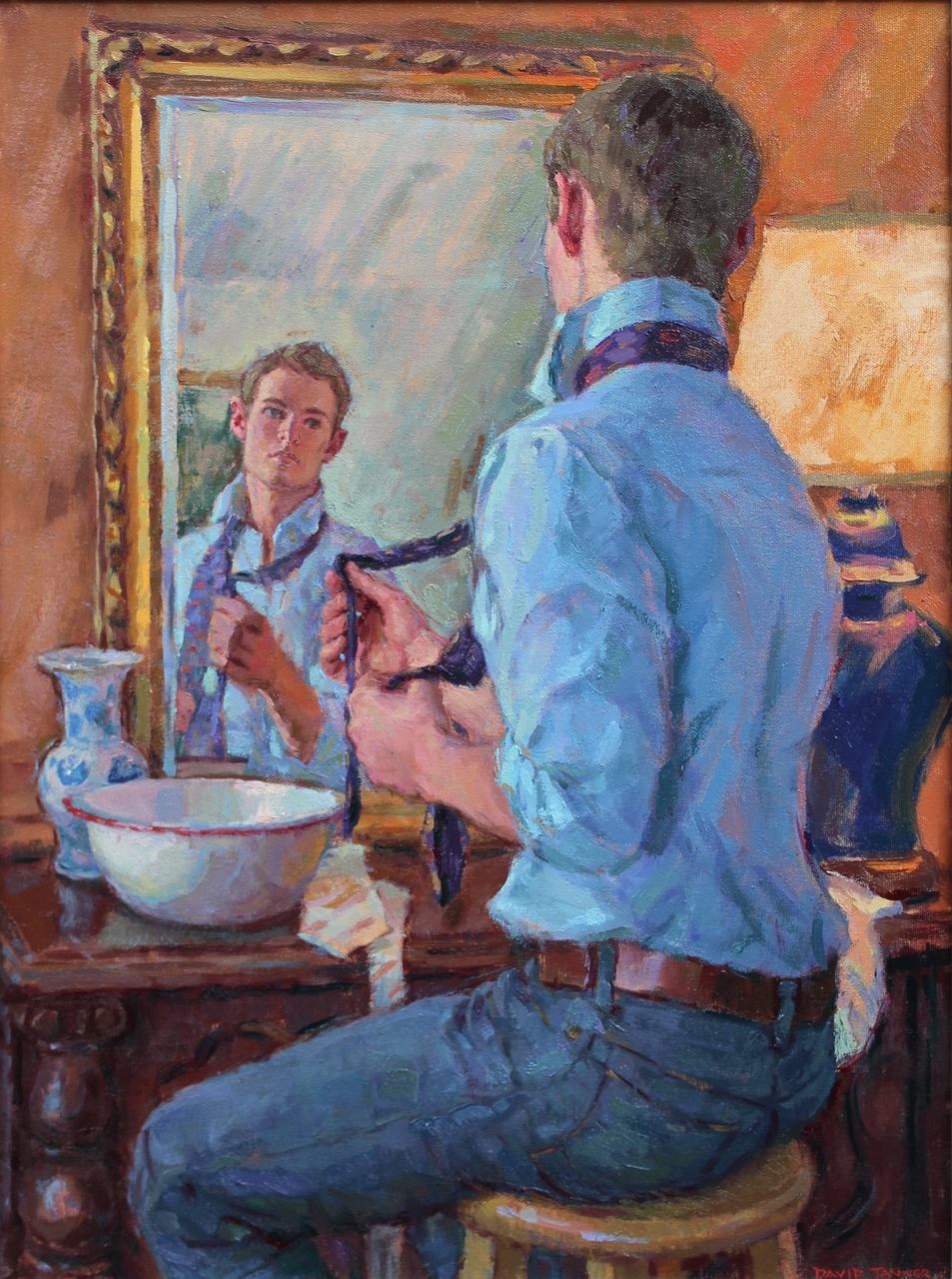
Above, you’ll see an example of a small 8 x 10 color study done from life, together with the 24 x 18 painting “Fit to Be Tied” that was created from the study. The color study need not be highly detailed, but it does need to describe the colors and values the naked eye is witnessing. While a camera is great for recording detail, it’s less helpful in giving an accurate record of the subtle shifts of color temperature and value variations. Having the color study to refer to while working on the finished painting is literally having an eyewitness account of the scene at my disposal. I augment this with the photo references to remember details.
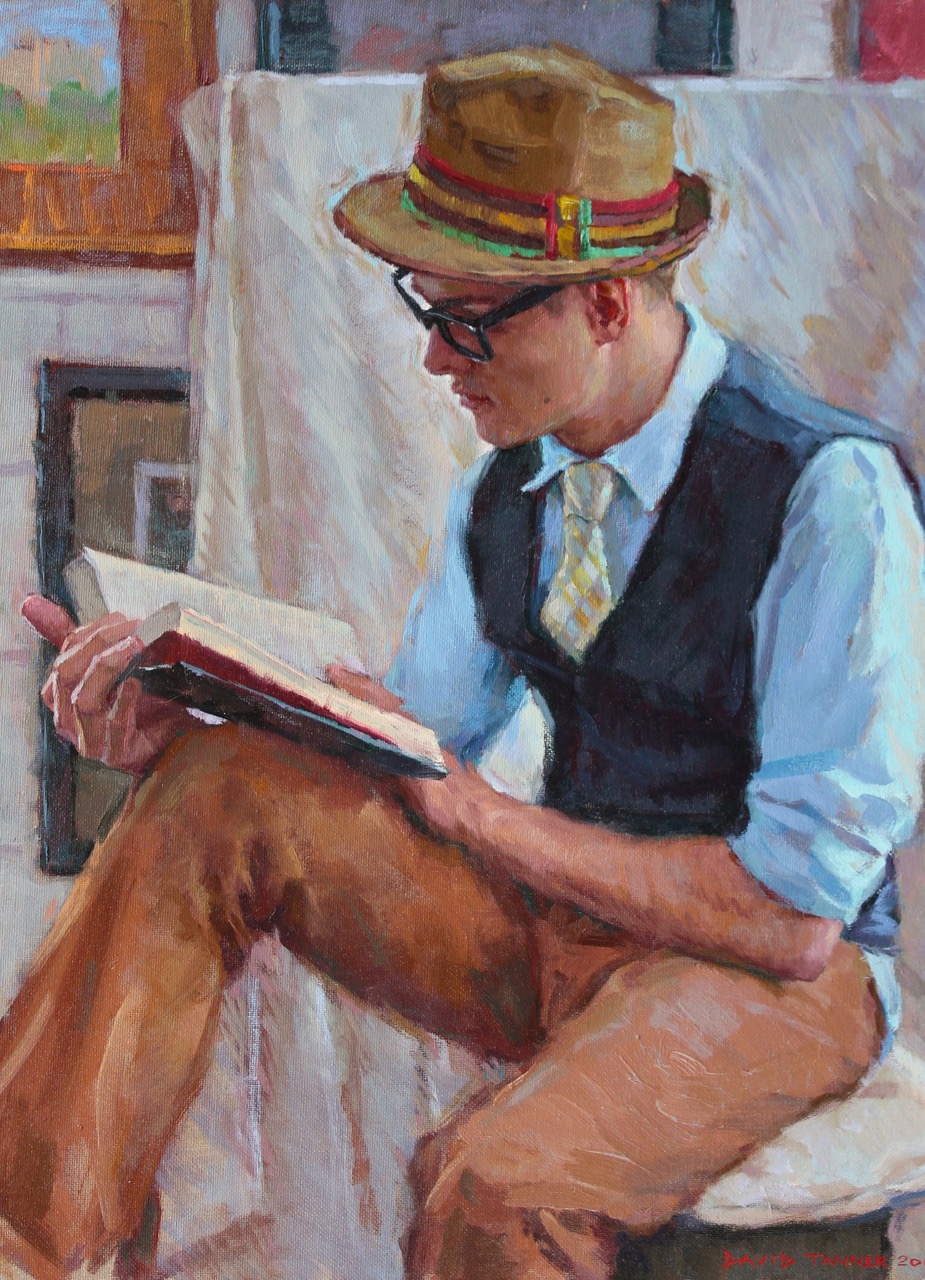
Art Models in a Narrative Painting
I have always enjoyed using actors and dancers as art models. Because they’re accustomed to playacting, it’s not a stretch for them to understand how we might apply a narrative to a painting, and be assigned the “part” of a character.
Joe was an actor I met through some friends in local theatre. Inspired by seeing him wear a retro pair of glasses in a play, I asked that he borrow them from the prop department. The clothing choice was also inspired by costuming I had seen him wear on stage.
Representational painting is nothing more than breaking down what we see into color/value masses. Don’t underestimate the importance of clothing selection when painting the figure, as the clothing’s color, value, and shape bring visual rhythm to the piece.
The reading theme was based on conversations that gave the impression that the model was bookish, so the concept seemed a natural posing situation for him. It was explored in both “Page Turner” (above) and “Joe With the Morning Paper” (below).
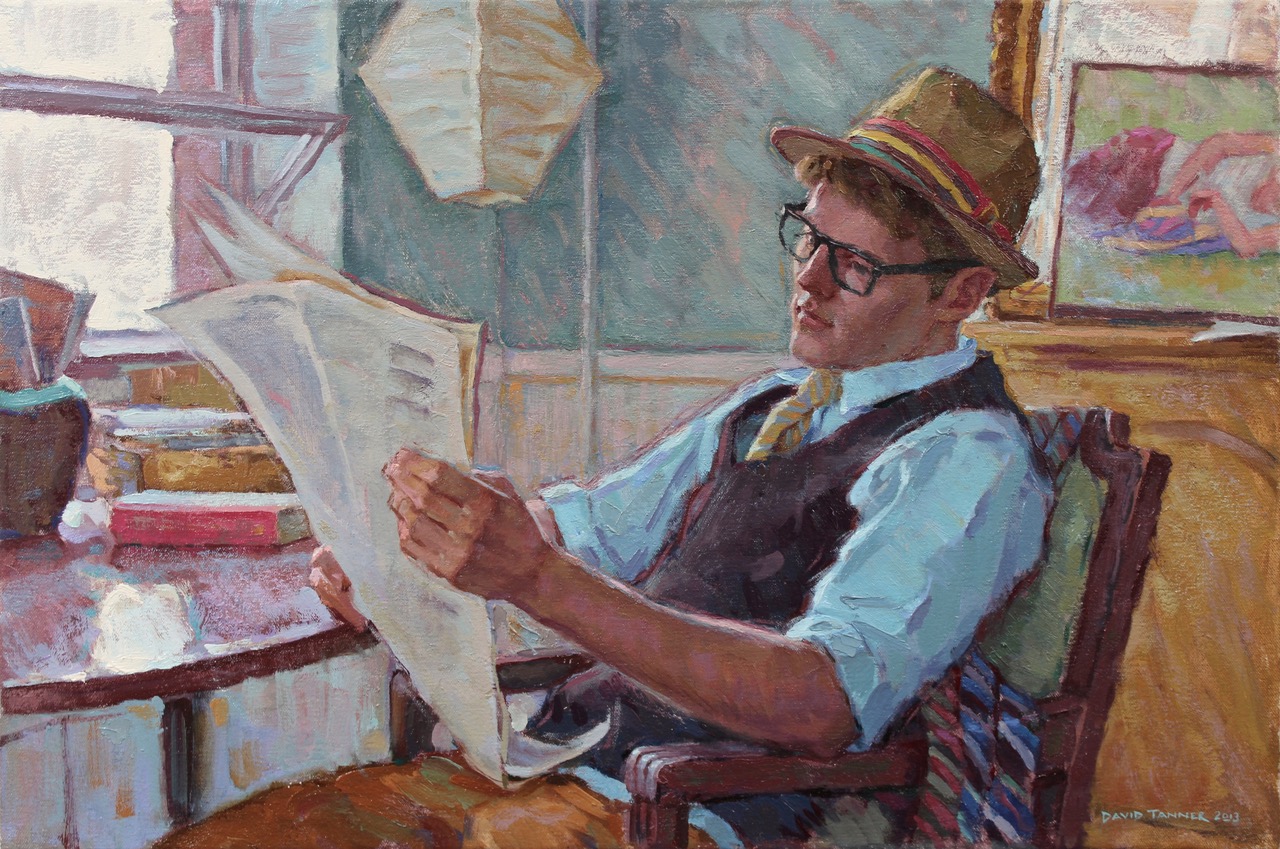
In 2013 I was invited (along with four other painters) to do a series of paintings of the Richmond Ballet. We had access to dress rehearsals in the ballet studio to inspire our paintings, and we were allowed to observe, sketch, and photograph behind the scenes.
The resulting paintings culminated in an exhibition, with a portion of the sales benefiting the dance company. Dancers, like actors, are accustomed to being on stage and are naturally theatrical. This was an opportunity I did not want to miss!
Conversations with company dancers inspired the concept of the painting “On the Mend” (below). I was interested in how a dancer recuperates after a performance or the rigors of a rehearsal. Both are physically punishing to a dancer’s body.
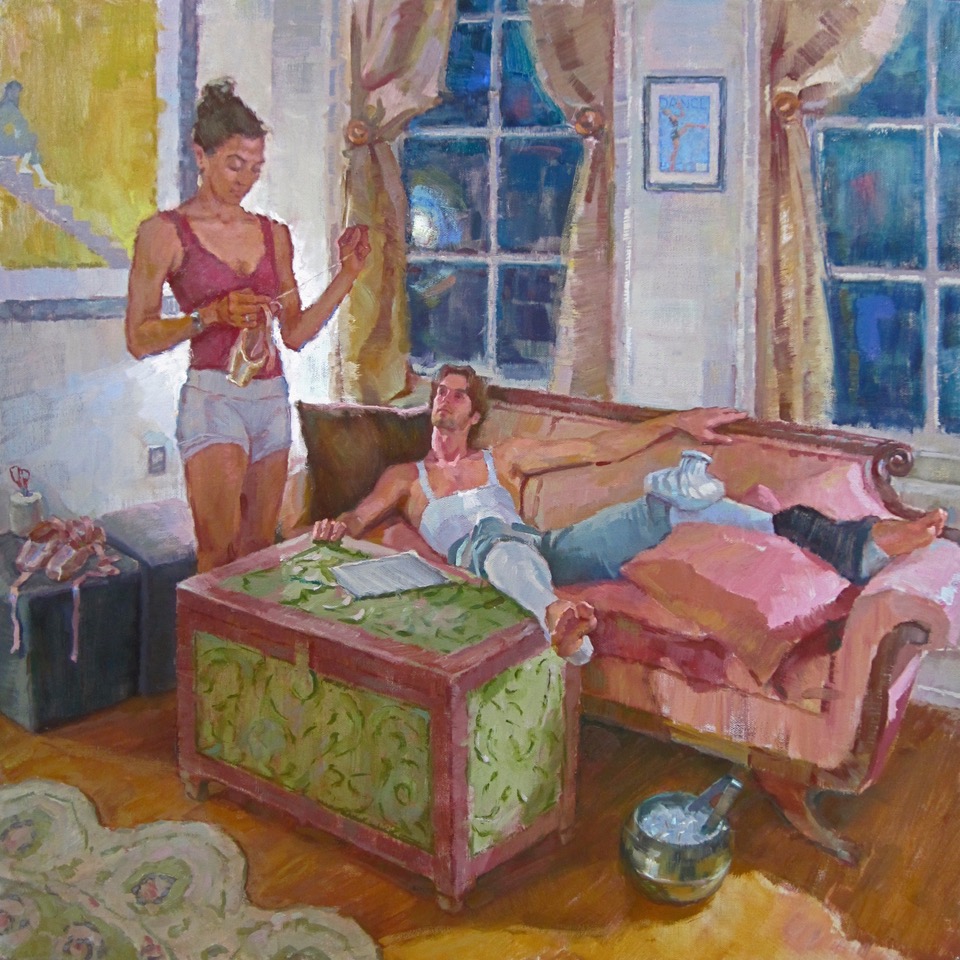
Every dancer I spoke with used ice packs on a regular basis, and Tommy, the male subject in this painting, was particularly forthcoming about nursing injuries. I began to imagine a painting on this theme.
Pictorial possibilities further expanded when I learned that he and another company dancer, Maggie, shared a life together off-stage. Maggie had previously spoken of sewing her pointe shoes in the evenings, and this concept, coupled with Tommy icing his knee, became my compositional idea.
I decided on a domestic situation as a setting for this theme, as this would underscore how pervasive the effects of their art are to their life off-stage.
Tommy and Maggie welcomed me into their home for two evenings to work out the composition. Maggie took several seated and standing positions with her mending, and Tommy posed in various sprawled positions on the sofa with an ice pack on his leg. If we had been in my studio, I would have had limited props, so an apartment interior in an actual domestic setting gave me many more visual elements to consider. Every piece of furniture or decorative item could contribute as another color/value shape in the painting.
At one point, I asked Tommy to look up at Maggie as she was sewing. I knew I had my painting when I saw the natural affection in his expression. Having more than one “character” in a painting has the great benefit of allowing the models to play off of each other.
Titles often come to me during quiet moments. In this case, thinking about the concept of one dancer’s recuperation, and another’s task in sewing and repair, the double meaning of “on the mend” came to me. It seemed like a perfect descriptive title for this narrative painting.
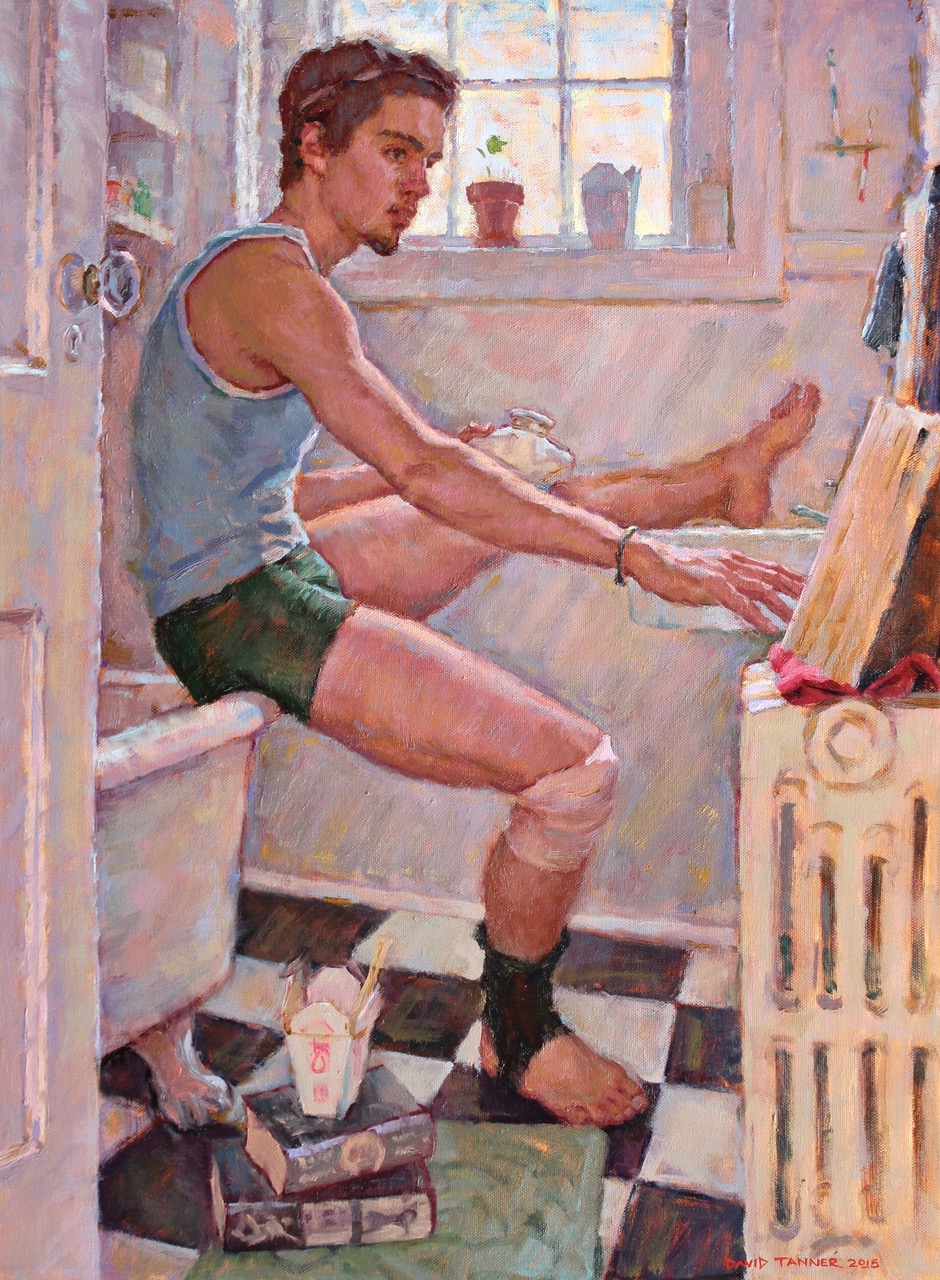
“An Icepack & Chinese Takeout” pictured Ben, another member of the ballet. Revisiting the icepack motif from “On the Mend,” I wanted to express life going on beyond the stage but still influenced by the work. Nursing an injury can’t stop the daily routine of a dancer’s life. The idea of takeout implies a quick fix for the basic human need of hunger, which further underscores a dancer’s dedication. He doesn’t have time to prepare a proper meal. He’s been rehearsing all day and needs to get to bed, so he must eat, read, and ice the injury all at the same time.
As with Maggie and Tommy, setting the painting in Ben’s apartment gave me access to domestic elements that would not be available in my studio. The bathroom setting included a radiator, a claw-foot tub, and a sink, all elements of visual interest for the figure to engage with. Staging a painting outside of the studio opens a world of possibilities.
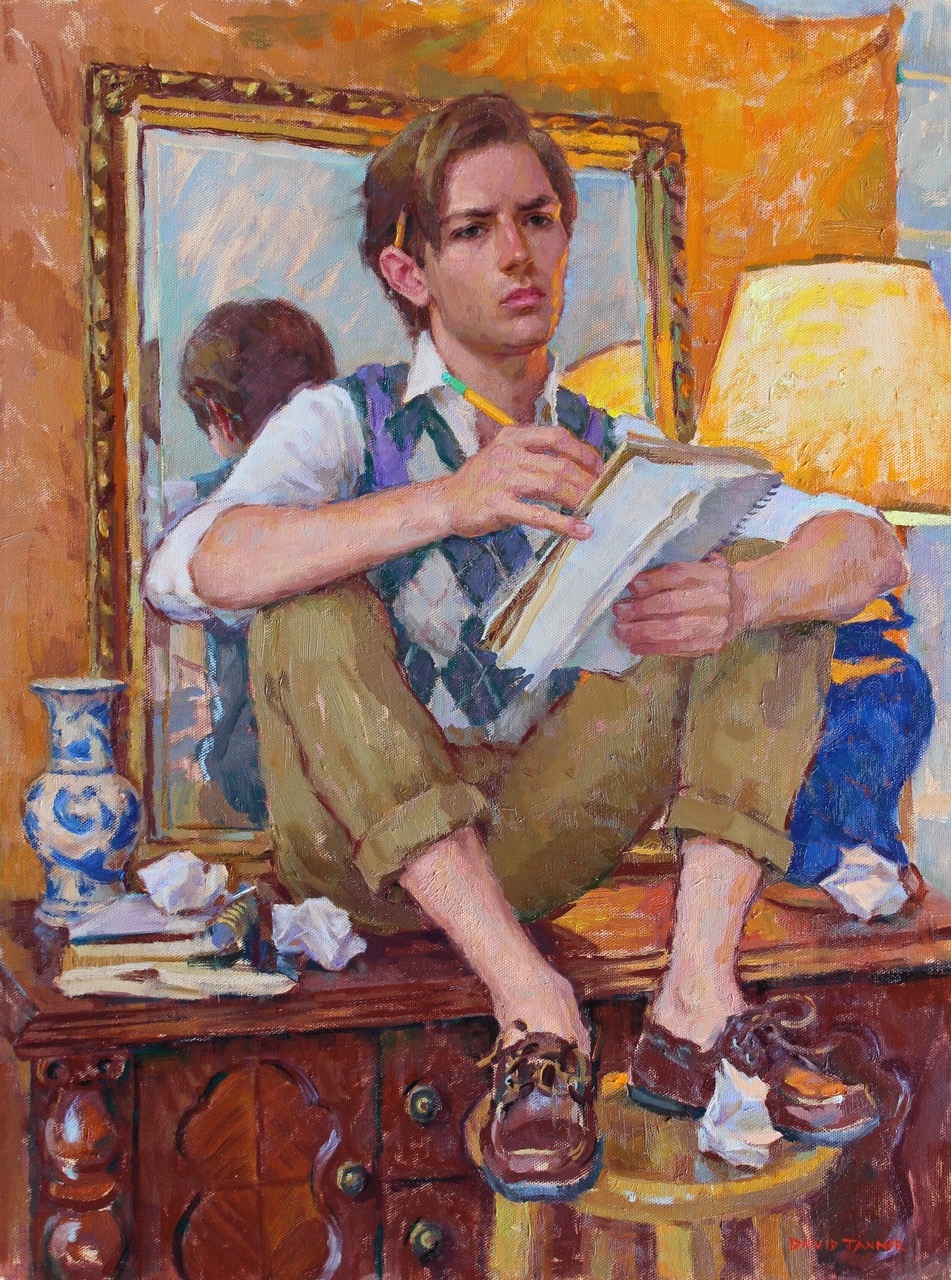
When limited to working in my studio space, I use the tables, chairs, or other furniture in the space, moving them around as necessary. Augmenting them with lamps and other props helps to dress the scene. I can easily change the wall color by tacking yards of colored cloth to the wall. The paintings “First Draft” and “Fit to Be Tied” were painted two years apart, but set in the same corner of my studio. You’ll notice the same lamp, mirror, vase, and cabinet in both.
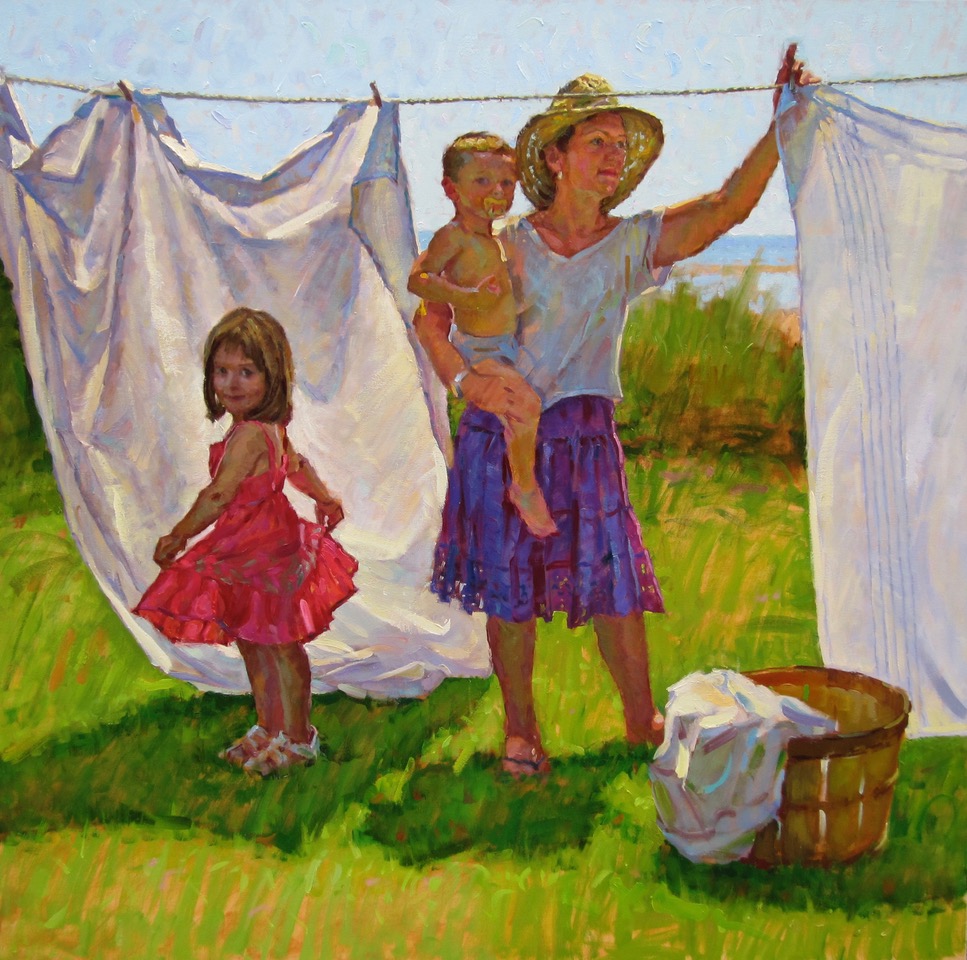
Sometimes a narrative painting can be inspired in response to viewing great art. In 2009, I was fortunate enough to travel to Spain for a major retrospective of one of my favorite painters, Joaquín Sorolla (1863–1923). I love the Spaniard’s bold use of color and lively brushwork in his outdoor figures. Seeing them in person was like a master class in painterly painting. I returned home completely inspired, and within a few months, I decided to stage a sunny outdoor domestic scene with my niece and her children as models.
In this case, the narrative for my painting evolved out of an attraction to Sorolla’s convincing depiction of a particular lighting condition. For “The Laundry Line” I worked larger than usual, and tried to maintain vigorous, bravura brushwork to express the high-key nature of the backlit sunlight.
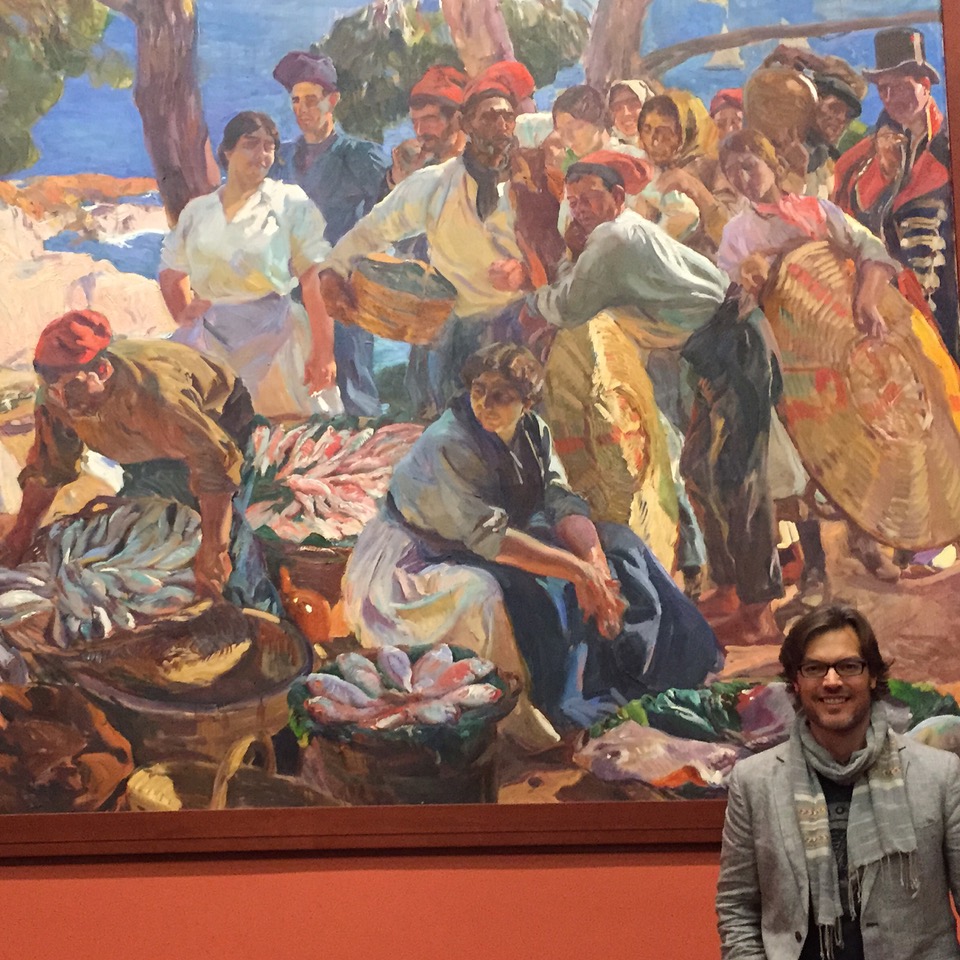
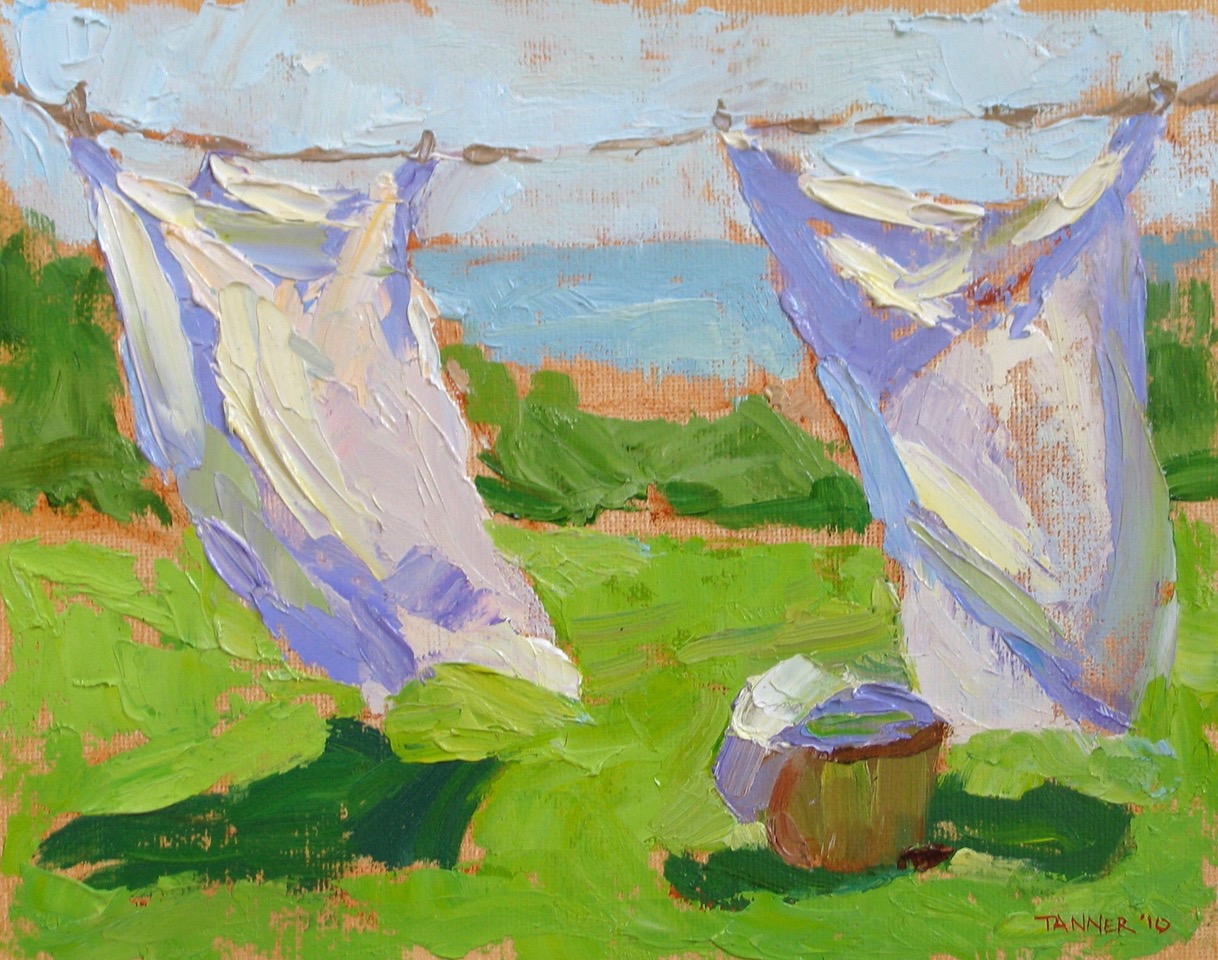
While I’ve had adult models pose for live painting sessions outdoors, it was out of the question with two children under five years of age. I relied on multiple photographic references of the figures shot on location on a sunny summer morning in 2010. The next day, under similar weather conditions and around the same time of day, I did this small 8 x 10 sketch on location. Having it as a reference back in the studio was invaluable, as it captured some of the atmospheric qualities of the outdoor light that the camera could not.
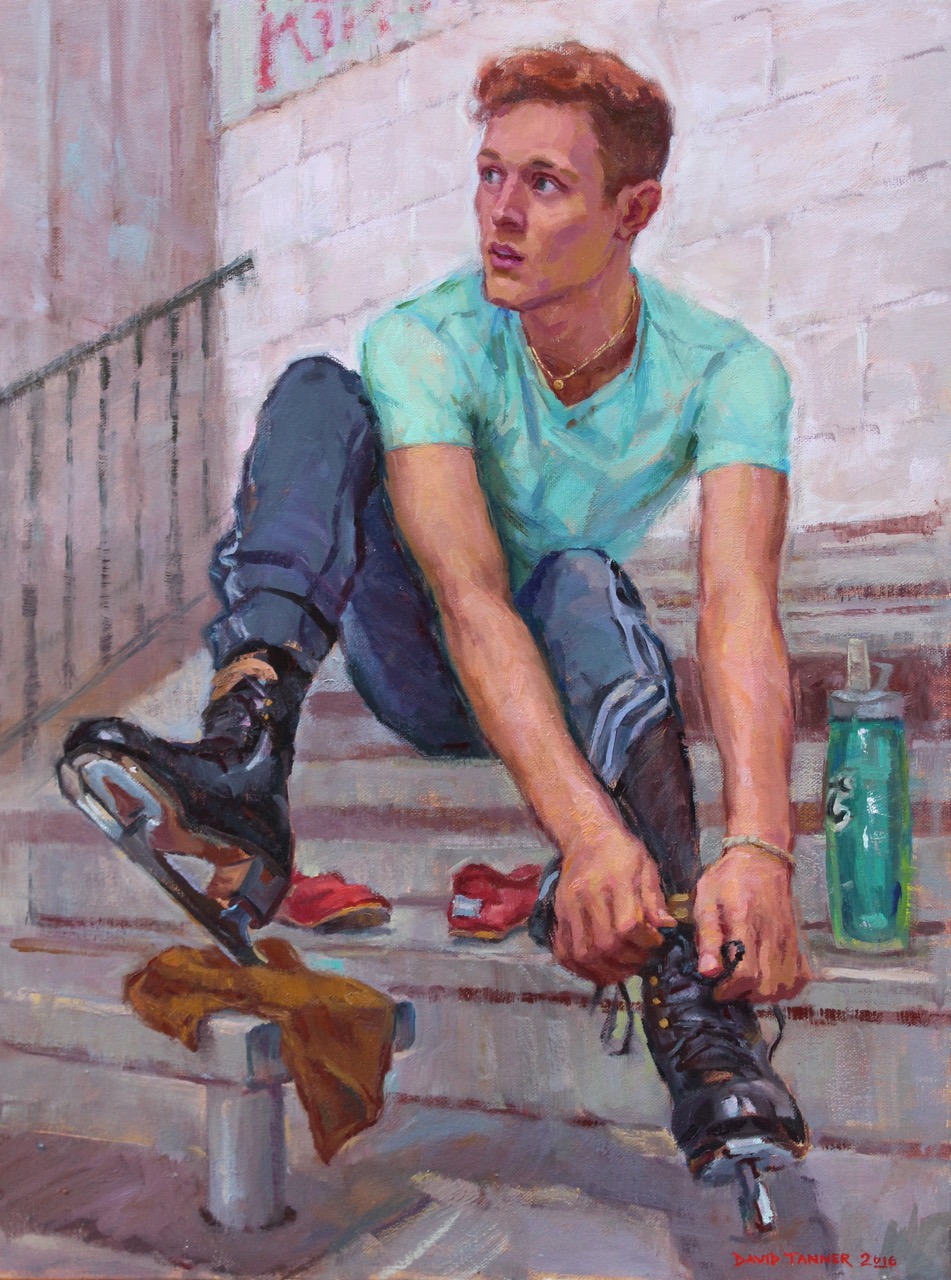
Because everyone has a unique story, I’m always open to hearing about a model’s life and interests, with the possibility of building a narrative around their uniqueness. It’s important to be open and to listen, because often a great storytelling possibility is just handed to you.
“Late for Practice” was inspired by model Josh’s experience as a semi-professional figure skater. A painting of him skating may have been a bit too obvious and cliché, so I described by implication, using the prerequisite of lacing his skates to tell a story.
The Importance of Balancing Planned and Spontaneous Painting
The paintings described up to this point fall within the category of what I call “planned paintings,” in that a great deal of preparation takes place in anticipation of the finished project. However, it is important to understand that many, if not most, of an artist’s working hours are devoted to painting without any great level of expectation. In the classes I teach, I call this “spontaneous painting.” In these paintings I’m not concerned about crafting a poetic narrative or a perfectly designed composition (or worrying about a potential sale). I simply record the shapes, colors, and value relationships before me, as quickly and efficiently as possible. These alla prima painting sessions, limited to two to three hours to paint a study from life, are the meat and potatoes of developing my — or any artist’s — ability to “see.”
Possibilities for spontaneous painting include going outside and working en plein air, with no advance planning of what is to be painted; chipping in with friends to hire a portrait model and deciding the pose on the spot; and, in my case, painting a quick still-life or figure as a demonstration for my students. In each of these circumstances, my goal is simplifying what I see down to the most basic visual elements, but still clearly representing what’s before me. Limiting my time will force me to look beyond the details for the major color/value shapes, and then quickly translate them into the corresponding color mixtures on my palette.
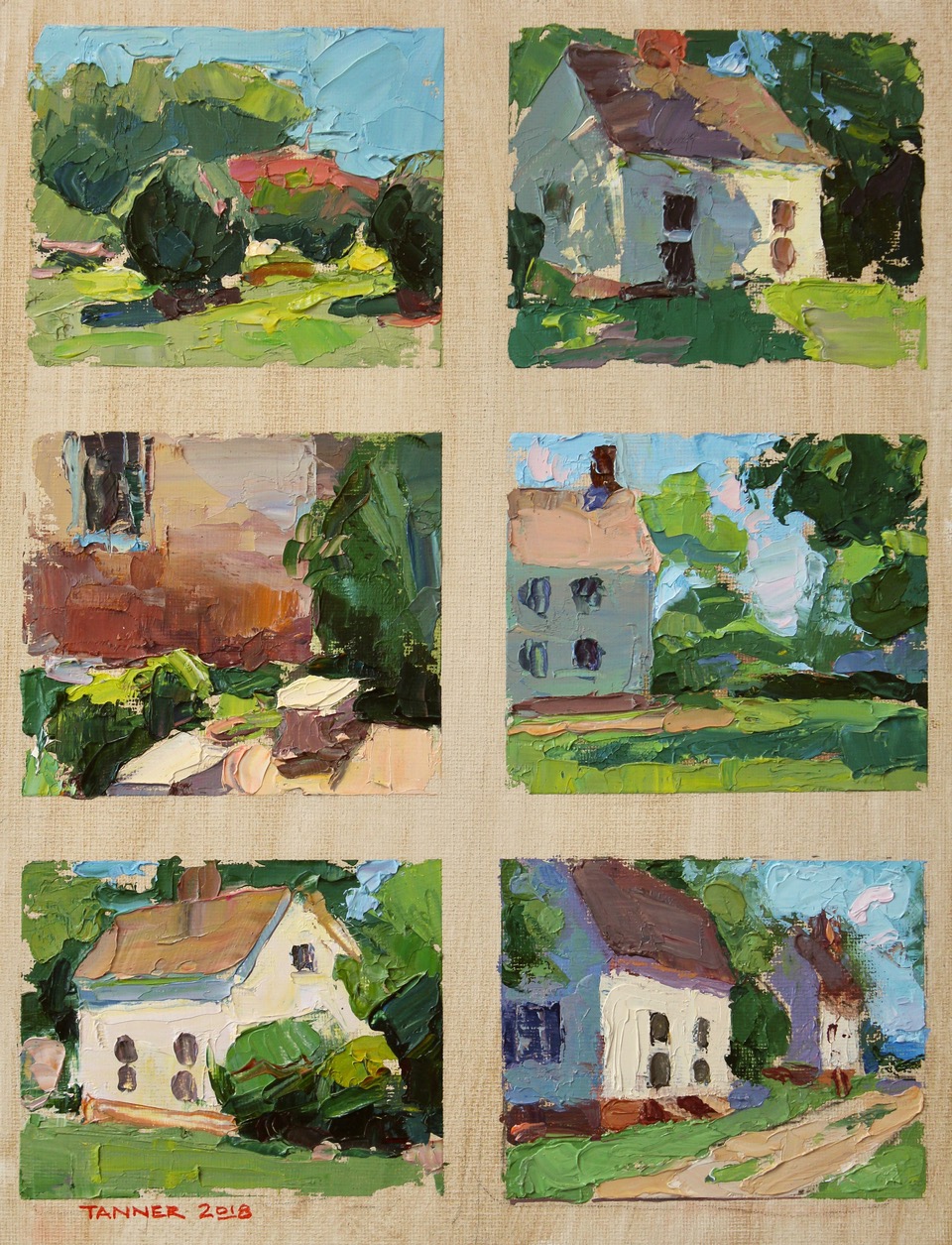
This set of small paintings, “Studies From Tuckahoe Plantation,” was done in a single afternoon on an 11 x 14 canvas panel divided into six sections. What they lack in detail they make up for in describing the core colors and shapes in as few strokes as possible.
When I consistently put myself in spontaneous painting situations, I not only give myself pressure-free practice time, but I also open the door to inspiration. I often experience something that fuels a future work of more complexity. A delightful by-product is that some of these impromptu works end up being among my favorite paintings. Some I keep, some I sell. A visit to my website or a gallery showing my work reveals examples of planned and spontaneous paintings, presented side by side.
About the Artist
David Tanner is a representational oil painter in Richmond, Virginia. Since receiving a Bachelor of Fine Arts degree in illustration from Virginia Commonwealth University in 1991, his study of traditional painting technique includes workshops with modern masters Nelson Shanks in Philadelphia and Robert Liberace in Washington, DC.
After more than a decade of commissioned oil portraiture, David has focused on figurative and plein air painting since 2006. Frequent traveling has provided rich opportunities for capturing the light and color of locations in Russia, Italy, Spain, Morocco, and Great Britain. While visiting painting collections in these countries, David has studied the work of Sargent, Sorolla, Zorn, Repin, and other late 19th- and early 20th-century masters.
Juried national exhibitions include Oil Painters of America, Salon International, Plein Air Richmond, and Bath County Plein Air Festival. National awards include ten paintings honored in the Portrait Society of America’s Members-Only Competition between 2011 and 2017. In 2018, his painting “First Draft” was awarded a Certificate of Excellence in the Portrait Society’s International Portrait Competition. Other honors include placement in art competitions hosted by PleinAir magazine, The Artist’s Magazine, Raymar Fine Art, and BoldBrush.
David’s “Self-Portrait” won first prize in American Artist magazine’s annual competition and was featured on the cover of this respected publication in September 2012. He has also been featured in Fine Art Connoisseur and American Art Collector. A five-page interview on his working methods can be found in PleinAir magazine, April 2015. In November 2016, David was interviewed for PBS television’s Virginia Currents.
David is an active member of the Portrait Society of America, and teaches oil painting at the Visual Arts Center of Richmond, where he was elected Master Teacher in 2006.
Check out David’s “Behind the Scenes” blog: Behind the Scenes
Check out David’s interview on PBS-TV’s Virginia Currents: Interview with David Tanner
Check out David’s blog on painting the Richmond Ballet: Painting the Richmond Ballet


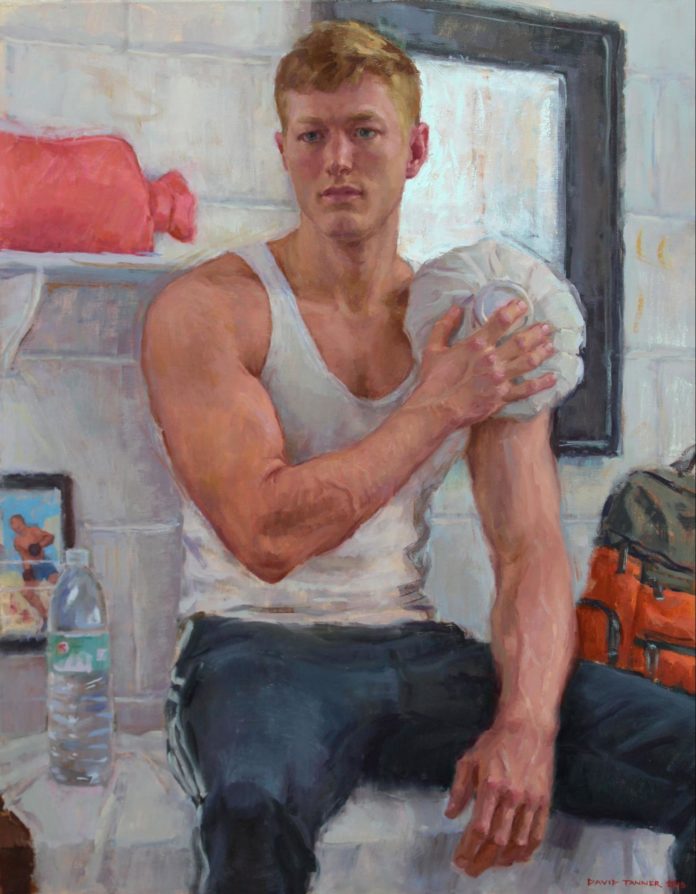


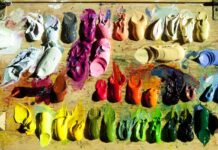
EXCELLENT, David… Your figurative work is amazing. We can all learn from you. 🙂
Comments are closed.